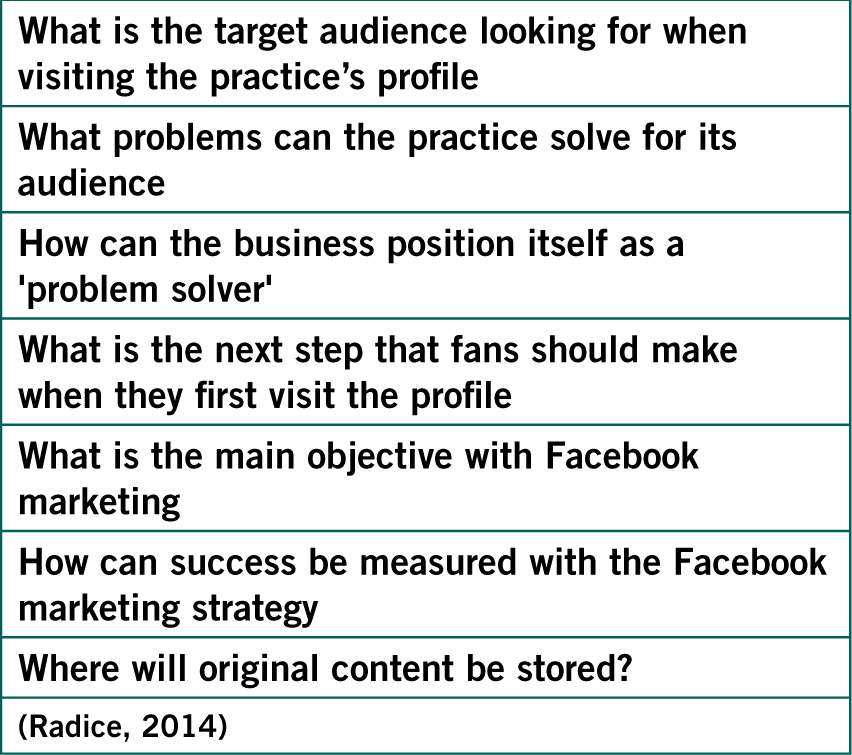Establishing a presence on social media is not as straightforward as it first seems. Social media has put marketing into the hands of individuals and when it comes to veterinary practice, this often means responsibilities fall to staff members who otherwise may not be familiar with marketing strategies. Setting up a social media profile for a business is significantly different than creating a page for an individual. The profile must show who the practice is and offer ways to learn more about the business, but it must also entertain and educate to keep people interested in the practice's profile (Hanbury, 2011).
Fans expect a lot and are easily swayed by unattractive profiles, poor grammar, unprofessional names and descriptions or uninspiring presentation. With only one click and a few moments of contemplation they may choose to unfollow a profile if it does not live up to expectations. Therefore, it is important to establish a profile that is professional, useful, appealing to the eye, and entertaining to fans. Ultimately, a good social media profile will present the business well and will hopefully keep current fans, as well as attract new ones.
Making a plan
Before developing a presence in social media it is useful to establish a plan to ensure consistency and the best outcome. The practice should be looking to outline ways of building and growing a loyal fan base and there are many factors to consider when doing so. While there are some basic rules of planning for a successful social media profile (Figure 1) it is also very important to keep in mind the reasons why the practice wants to develop a social media presence in the first place as these guiding principles will help direct the practice to make effective decisions.

Another thing to consider is the message that the practice gives out with its social media profile. The profile should be catchy and draw in visitors and potential followers (Hanbury, 2011). Attracting the right audience requires that they are targeted specifically based on their interests. Start by writing down a few key ways that the business differentiates itself from others (Figure 2). Then, build the profile up to represent these principles and showcase what the practice has to offer to potential followers.

Developing a professional profile
At the centre of social media is the connection people get to a wider community and in a way, this digital environment is like a farmer's market where consumers are browsing what is on offer and enjoying the local scenes and activities. Many people enjoy shopping and while they shop, they chat with others and get to know their service providers. For providers, there are chances to showcase the business and opportunities to educate and entertain. Comparing social media, to a farmer's market, it is easy to see that the content on social media profiles should be showing fans attractive scenes, capturing their attention, telling them about the practice's values by showcasing what goes on behind the scenes, teaching them about pet care, telling them interesting stories that are relevant to their lives, and advertising the occasional sale. The social media plan should focus on this type of approach, presenting the profile like a farmer's market stand, showcasing the practice, fostering interest, providing what people need and making visitors want to come back (Figure 3).

The right person for the job
Appointing the right team member to the task of managing the practice's social media profile is important for success (Raulf, 2014). Good management of content helps ensure that the business is well presented over all platforms and that the right audience is being targeted. It also helps ensure that the content itself is meeting expectations of fans and potential clients.
Each social media platform has its own character. People use platforms that suit their lifestyle so it is useful to have a presence on more than one platform in order to reach more people. For instance, people enjoy taking photos on their mobile devices and practices can capitalise on that by promoting their Instagram hashtag on the practice's Facebook page. For instance, if it is the first day of summer, the practice could promote a ‘Dog days of Summer’ theme using the hashtag #dogdays and encourage clients and fans to take photos of dogs enjoying summer. Or, the practice can have a set hashtag which they promote in all of their profiles and encourage clients to tag any pet-related photos (Figure 4). Then, the practice can search the hashtag and repost the best fan photos garnering goodwill and helping to create a community buzz for the practice (Bennett, 2014).

Using different platforms requires a good knowledge of their particular strengths and weaknesses as well as an awareness that content needs to be tailored to suit different audiences. It is therefore important to ensure that the people posting content present it in a way that relates to the fans of the particular platform. Choosing the right person to post is probably one of the most important aspects of a successful social media presence. Choose a good person for the job and much of the hard work is already done. Fans want to relate to what they are seeing so the more human a post is, the more people will relate to it and engage with the content. Each person has their own style and strengths, and the voice they use to post content can make or break the post in terms of how engaging it is. A positive, witty approach will attract more attention than one that is bland and has no character so not only is it important to compose posts well, it also helps to portray a pleasing personality.
Choosing a platform
The social network chosen for the practice's online presence is important in that the practice ideally wants to engage with the platform that most of its clients are using; however, if the practice does not already have someone who is skilled at using that social network, then the chances of success could be lower so it may be more important to pick a person to post before picking a social media platform. If a person is already familiar with a particular social network they will be used to communicating in the local language and respecting the community etiquette — this familiarity is a great advantage to the practice as users of social media can quickly become disinterested if the post is obviously from an inexperienced newcomer.
Different social networks will appeal to different personalities and knowing this can help the practice choose a suitable person to post its content. For instance, Twitter is well suited to someone who is witty and humorous, and who likes to be kept current on the latest news or at the centre of the conversation. In contrast, Instagram is good for someone who is creative and who enjoys photography, visual communication and exploring their community. Pinterest is ideal for someone who is efficient and able to see the bigger picture, enabling them to curate and organise all of your content in one place. Facebook is a good platform for someone who is adept at the intricacies of presenting a diverse range of content, engaging with the public, and dealing with queries and feedback (both good and bad).
Developing the profile
Once the platform has been chosen and the person or people have been picked to post content, the profile needs to be developed. How this is done will depend mostly on the platform, but some general rules can be applied to all platforms:
- Professional vs personal accounts — always choose a professional business profile over a personal profile and get it verified by the network to add greater trustworthiness to the practice's brand (Sorokina, 2014). Professional profiles are different from personal profiles in that they are designed to allow fans to follow and customise what they see. Professional profiles can also offer analytics for businesses by-helping businesses to see which types of content is attracting the most attention.
- Name — this might seem obvious but the name chosen for the practice's social media profile needs to be logical so that potential fans can easily find it if they look it up. Acronyms or abbreviations should be avoided unless it is a very well-known brand. Keep in mind also, that very long names should be avoided if possible as they will create problems such as cut offs in newsfeeds and overly long URLs.
- About — the ‘About’ section is not just a biography, it is an opportunity to grab the attention of potential fans (Radice, 2014). Above all else, be sure to add a web link to the practice website. Then, add information about the practice like a tag line, call to action or the practice motto, but avoid making it too wordy and keep in mind how many lines will be visible when users first stop by the page – avoid making fans click to read more.
- Avatar — the avatar is the thumbnail image, by the name, that users will see in their newsfeeds. It is a small image so it should be easily recognisable from a distance. Above all, be professional. A compact business logo or symbol stands out as a business better than an image of a kitten. Also, even though this image is small, make sure it is of moderate to high resolution so that when users click on it to view a close up they are not disappointed by a pixelated image.
- Cover images — a good cover image cannot be understated. Research the image size needed for that particular slot on your profile and find an image that complements the space nicely. Use quality images, even if it costs a small amount. Have the images branded with the company font, logo or other significant symbolism. Make sure all the images and content on the page carry the same branding. Nothing says ‘professional’ like good branding so it is worth investing in this from the outset and it is a small price to pay considering just about everything else is free.
- Contact — at the very least, be sure that fans can contact the practice easily via private message, then, reply promptly when they do (Radice, 2014). The practice can also add links to its other social media channels so that fans can engage with whatever platform suits them. Remember, this is like a digital farmer's market, represent the practice well with a smile.
Establishing a fan base
The veterinary practice's social media profile should not just be for existing clients; it should also be about the practice's wider community presence. Generating good will in the community builds loyalty from followers as well as more opportunities to get referrals and attract new supporters.
In most cases veterinary practices can expect to take a year or more to reach 500 followers but if the marketing of the practice profile is strong, and it is posting content that its fans are liking and sharing, then numbers can grow quickly. Profiles with less than 500 fans generally do not attract a lot of attention in people's newsfeeds but diligence over time pays off so in the early stages it is important to keep posting good content regularly and often, until the fan base grows large enough to start sustaining itself.
Content
Choosing suitable content is a significant topic unto itself. There is abundant research about which type of content is best, when to post, and how to post to increase fan engagement. This is a much larger topic than can be covered here, but suffice it to say that content is the single most important aspect to keep people coming to the practice's profile regularly, and content that is good enough to be shared will drive new followers to the profile (Dodaro, 2014). Without good content, a social media profile is almost worthless so the practice must keep current on the latest marketing research about social media content trends and also look for good examples of professional businesses that are already successfully using social media (Figure 5).

Conclusion
Free profiles on social media have put a lot of marketing opportunities into the hands of novices and while it is tempting to try out social media, results can be less than remarkable unless the practice has done its research and planned well. Setting up a social media profile might seem easy, and for the average computer-savvy person the steps are simple, but what is not obvious is the little things that encourage user engagement and lead to loyal supporters. Word of mouth advertising has in some ways been replaced by small things like social media users seeing how one of their friends has liked a business, or shared some of the business' content. Referrals happen a lot faster when practices have a good social media profile and there is a higher potential for a practice to establish itself as a community icon.
The savvy practice will create a social media profile that is dynamic and engaging with content that is exciting, entertaining, and educational.
Key Points
- Creating a social media profile for a business is significantly different than a personal profile.
- Choosing the right social network is important to target a specific audience.
- Appointing the right person to post is one of the most important things to keep in mind when choosing a social network.
- Pick a name that people can find easily if they search for the practice profile.
- Invest in good branding.
- Always include contact details, hours of operation and the practice website address.


